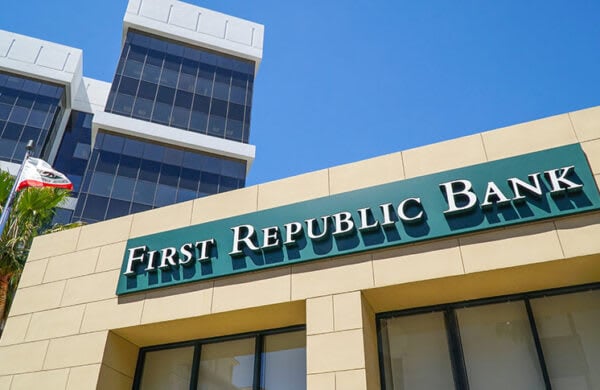Just days ago, First Republic Bank boasted of another coup for its wealth-management business: poaching a six-person team from Morgan Stanley in Los Angeles.
That followed hiring sprees targeting Bank of America Corp., JPMorgan Chase & Co., Bank of New York Mellon Corp. and Wells Fargo & Co. — raiding crews in Boston, New York and Palo Alto, California. It reflected how the San Francisco-based bank was rapidly expanding on the back of tech riches.
Now First Republic is racing to reassure customers and clients that it can avoid the fate of Silicon Valley Bank, which collapsed last week after its depositors fled.
First Republic’s stock plunged 28% on Thursday and is down about 80% since March 8. It’s exploring strategic options including a sale, and is expected to draw interest from larger rivals. JPMorgan and Morgan Stanley are among those discussing a potential deal with the bank that could include a sizable capital infusion, the Wall Street Journal reported Thursday.
It’s a stunning turn of events for the lender, which built up a wealth-management franchise with some $271 billion in assets, putting it in rarefied air among American institutions. Yet it’s the emphasis on that business that could make First Republic’s fate different from SVB and New York’s Signature Bank.
While it expanded rapidly into capital call lines of credit and lending to venture capitalists — services in which SVB specialized — its specialty serving the affluent is seen as making it more attractive than its California counterpart.
“First Republic Bank grew up in wealth,” whereas “SVB started in portfolio companies,” said Joe Maxwell, managing partner at Fintop Capital, a fintech venture capital firm. Even though there’s a lot of overlap, where they started is still “part of their DNA,” he said.
A representative for First Republic didn’t immediately reply to a request for comment. Emails sent to the leaders of its newly added adviser team weren’t immediately returned.
In a March 12 message to clients, signed by Executive Chairman Jim Herbert and Chief Executive Officer Michael Roffler, the bank said it has taken steps to bolster its liquidity with access to additional financing from JPMorgan.
“For almost 40 years, we have operated a simple, straightforward business model centered on taking extraordinary care of our clients. We have successfully navigated various macroeconomic and interest rate environments,” they said.
DIFFERENT ORIGINS
First Republic’s origin story, in many ways, couldn’t be more different than SVB’s.
Herbert founded First Republic in 1985, based on a hunch that jumbo home mortgages to wealthy, established Californians was too good a business to pass up. SVB’s model of providing banking to startups was conceived a few years prior — over a poker game.
Yet in the coming four decades, as interest rates tumbled and hot tech money came to dominate American finance, their customer bases began to overlap.
First Republic started actively courting Silicon Valley’s tech wealth. The bank opened a branch inside Facebook’s campus in Menlo Park, California, in an effort to win over early employees on the road to riches. In San Francisco, it has a bank location inside Twitter’s headquarters on Market Street, which remains open.
Meanwhile, SVB’s offerings grew as founders and venture capitalists got rich, with the firm eventually buying wealth manager Boston Private in 2021.
Still, that wealth business pales in comparison to First Republic’s, which saw assets balloon to $271 billion from just $17.8 billion at the end of 2010.
MAJOR PLAYER
It was around that time that First Republic executives initiated a plan to transform its wealth division into a major player. Among its first deals was buying Luminous Capital, with $6 billion in client assets, for a reported $125 million in 2014.
“They weren’t penetrating the high-net-worth investment business very well” back then, said Luminous co-founder David Hou.
As assets continued to climb, eventually surpassing $100 billion, Hou and Mark Sear, his partner, opted to split from the bank. They left in 2019 to start Evoke Advisors.
Hou, Sear and other Evoke partners though have kept money with First Republic amid the past week’s upheaval. So have other clients and fund managers, some expressing love for the bank on social media and urging people to stay put.
One Silicon Valley investor said they planned to keep all of their personal and business funds with First Republic.
Despite not having its origins in tech, the investor, who asked not to be identified discussing private information, found First Republic better understood the complexities of private tech wealth than the big banks — and on an even footing with SVB.
They were introduced to both banks six years ago as an early tech employee and chose First Republic over SVB for its relationship management with clients. They now have a personal line of credit, mortgage and venture fund with the bank — and plan to keep it there.
That kind of resolution was put to the test again on Wednesday, when both S&P Global Ratings and Fitch Ratings cut First Republic’s credit grade to junk, citing risks that its clients would pull their money en masse.
NO CHANCES
Other First Republic clients are also hoping to see the bank get through the turmoil — but aren’t taking any chances.
Bay Area homebuyers are now resorting to “double apping” — submitting loan applications at a second bank just in case, said Joske Thompson, a real estate broker at Compass in San Francisco.
“To have a backup was unheard of just until last week,” said Thompson, who has been a real estate broker for four decades.
They’re not the only ones exerting caution.
A New York-based wealth-management firm catering to high-net-worth investors moved an upper-eight-figure amount of cash from First Republic last week, including money in checking accounts, corporate funds and certificates of deposit, according to a person familiar with the matter.
The person, who asked not to be identified discussing private information, said the wealth manager doesn’t intend to leave the bank forever, but is looking to spread cash around and diversify after SVB’s collapse.
The money is being rerouted to institutions including JPMorgan and BNY Mellon, the person said.
CULTURAL CONNECTIONS
Herbert, who was First Republic’s CEO for 37 years, has ranked among the highest-paid US executives. The bank’s board includes Colony Capital founder Tom Barrack.
Herbert’s compensation totaled $17.8 million in 2021, according to the company’s proxy statement. He has been on the board of institutions from coast to coast, including the San Francisco Ballet Association and New York’s Lincoln Center for the Performing Arts.
Herbert’s wife, Cecilia, has long been on the board overseeing BlackRock Inc.’s iShares exchange-traded fund complex. She’s also been on the boards of nonprofits including Stanford Health Care and WNET Group, a New York public media company.
Jean-Marc Berteaux had been a private wealth client with First Republic for more than 15 years when he and another customer introduced the bank to Boston Youth Symphony Orchestras, a nonprofit where they serve as board members.
“They’re supporting nonprofits with the understanding that they can grow their private wealth business,” said Berteaux, a retired investment manager.
He said his banker was on the phone with him Saturday and Sunday, making sure an insured cash sweep was in place to spread out the nonprofit’s millions in $250,000 chunks to other banks.
“Give me a mega bank that would have done that,” Berteaux said.
CONCENTRATION RISK
The similarities — and differences — between First Republic and SVB are visible on their balance sheets.
Both SVB and First Republic finance capital call lines to private equity and venture capital funds. But SVB’s $41 billion balance made up more than half of its loan portfolio. First Republic had $10 billion of such loans outstanding.
Both originate single-family mortgages, but SVB had lent less than $9 billion. That’s a fraction of First Republic’s $99 billion balance, which made up 59% of their loan portfolio (it gave Mark Zuckerberg a 1.05% rate in 2012). It had another $22 billion in multifamily loans and $11 billion in other commercial real estate.
One area of contrast is their deposit base. Consumer accounts make up 37% of First Republic’s, with businesses covering the rest. SVB doesn’t have the same breakdown in its most recent annual report, but notes deposits came largely from commercial clients in tech, life sciences, private equity and venture capital.
First Republic has said no sector represents more than 9% of total business deposits, while it has a smaller percentage of unsecured deposits than SVB.
Dick Bove, chief financial strategist at Odeon Capital Group, expects Royal Bank of Canada is most likely to bid for First Republic, drawn in by the wealth management business.
“Banks always want what they like to call the ultra-wealthy client group,” he said. First Republic clients have amassed wealth over decades, he said, while many SVB clients were at the whims of “hot money.”
Credited Article - https://www.advisorhub.com/first-republic-goes-from-wall-street-raider-to-prey-in-days/




